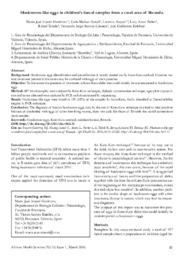Please use this identifier to cite or link to this item:
https://hdl.handle.net/11000/34350
Hookworm-like eggs in children's faecal samples from a rural area of Rwanda
Title:
Hookworm-like eggs in children's faecal samples from a rural area of Rwanda |
Authors:
Irisarri Gutiérrez, Maria José 
Muñoz-Antoli, Carla 
Acosta Soto, Lucrecia 
Parker, Lucy Anne 
Toledo, Rafael 
Bornay Llinares, Fernando Jorge 
Esteban, José Guillermo |
Editor:
African Journals Online |
Department:
Departamentos de la UMH::Agroquímica y Medio Ambiente |
Issue Date:
2016-05-09 |
URI:
https://hdl.handle.net/11000/34350 |
Abstract:
Background: Hookworm eggs identification and quantification is usually carried out by Kato-Katz method. However various structures present in the smear may be confused with eggs of such parasites. Objective: To document the presence of structures in Kato-Katz slides that could initially be misinterpreted as hookworm eggs. Method: 497 faecal samples were analysed by Kato-Katz technique, diphasic concentration technique, agar-plate coprocultive and larvae obtained were analysed by PCR and characterized by sequencing. Result: Hookworm-like eggs were found in 159 (32%) of the samples by Kato Katz, finally identified as Caenorhabditis elegans by PCR technique. Conclusion: The diagnosis of human hookworm eggs, only by the use of Kato Katz technique can lead to false positives because of similarities with eggs of other free-living worms, from wet soils like those of Rwanda that could contaminate stool samples
|
Keywords/Subjects:
Hookworm eggs
Kato-Katz method
Misclassification
Rwanda |
Type of document:
info:eu-repo/semantics/article |
Access rights:
info:eu-repo/semantics/openAccess
Attribution-NonCommercial-NoDerivatives 4.0 Internacional |
DOI:
http://dx.doi.org/10.4314/ahs.v16i1.11 |
Published in:
African Health Sciences 2016 Mar;16(1):83-8 |
Appears in Collections:
Artículos Agroquímica y Medio Ambiente
|
 ???jsp.display-item.text9???
???jsp.display-item.text9???

.png)
